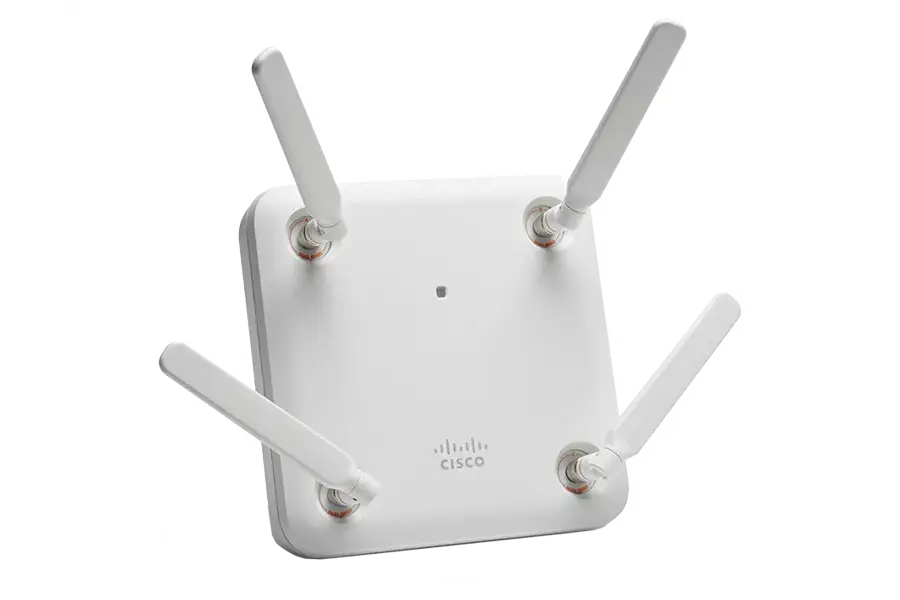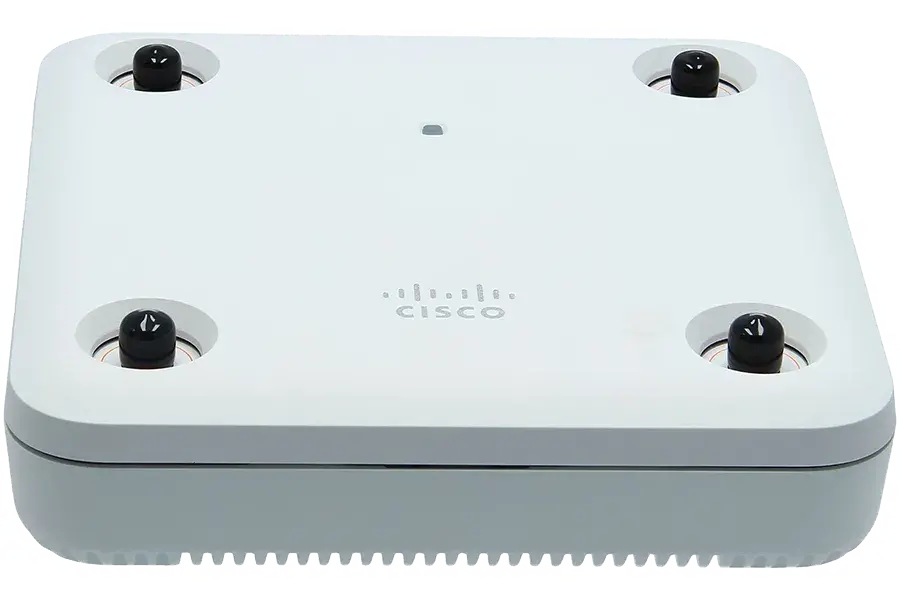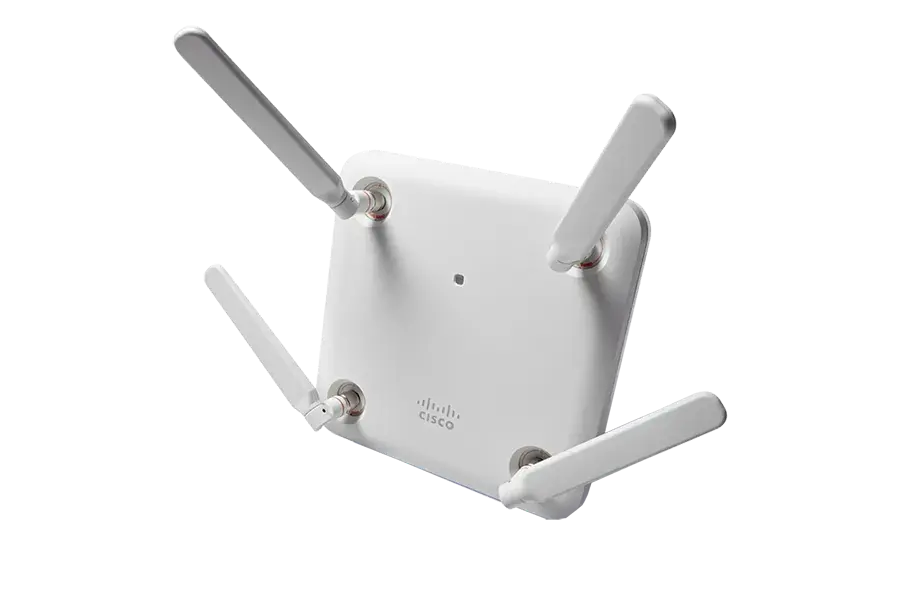


Cisco Aironet 1850e Access Point
Description 802.11ac Wave 2 Access Point, 4x4:4, External-Ant, E Regulatory Domain
Description
Product overview
Ideal for small and medium-sized networks, the Cisco® Aironet® 1850 Series delivers industry-leading performance for enterprise and service provider markets via enterprise-class 4x4 MIMO, four-spatial-stream access points that support the IEEE’s new 802.11ac Wave 2 specification. The Aironet 1850 Series extends support to a new generation of Wi-Fi clients, such as smartphones, tablets, and high-performance laptops that have integrated 802.11ac Wave 1 or Wave 2 support.
Features and benefits
With 802.11ac Wave 2, the Aironet 1850 Series provides a data rate of up to 1.7 Gbps on the 5-GHz radio, more than triple the rates offered by today’s high-end 802.11n access points. It also enables a total aggregate dual-radio data rate of 2.0 Gbps, providing the necessary foundation for enterprise and service provider networks to stay ahead of the performance and bandwidth expectations and needs of their wireless users.
Due to its convenience, wireless access is increasingly the preferred form of network connectivity for corporate users. Along with this shift, there is an expectation that wireless should not slow down users’ day-to-day work, but should enable a high-performance experience while allowing users to move freely. The 1850 Series delivers industry-leading performance for highly secure and reliable wireless connections and provides a robust mobility experience that includes:
- 802.11ac Wave 2 with 4x4 Multiple-Input Multiple-Output (MIMO) technology with four spatial streams when operating in single-user MIMO mode and three spatial streams while operating in multiuser MIMO mode, offering 1.7-Gbps rates for more capacity and reliability than competing access points.
- Multiuser MIMO, allowing transmission of data to multiple 802.11ac Wave 2 capable clients simultaneously to improve client experience. Prior to multiuser MIMO, 802.11n and 802.11ac Wave 1 access points could transmit data to only one client at a time, typically referred to as single-user MIMO.
- Transmit beamforming technology to improve downlink performance to mobile devices, including one-, two-, and three-spatial-stream devices on 802.11ac, while improving battery life on mobile devices such as smartphones and tablets.
- Flexible deployment mode through Cisco Mobility Express is ideal for small to medium-sized deployments that require multiple access points. Easy setup allows the 1850 Series to be deployed on networks without a physical controller.
- Secure connections for remote workers or the micro-office. Any Cisco Aironet or Catalyst access point can function as an OfficeExtend Access Point (OEAP). With an OEAP, an employee at home or in a temporary micro-office will have access to the corporate SSID and the corporate network without the need to set up a VPN or have any advanced technical know-how.
- Cisco User Defined Network, a feature available in Cisco DNA Center, that allows IT to give end users control of their very own wireless network partition on a shared network. End users can then remotely and securely deploy their devices on this network. Perfect for university dormitories or extended hospital stays, Cisco User Defined Network grants both device security and control, allowing each user to choose who can connect to their network. (Available second half of calendar year 2020.)
- The Wi-Fi 6 readiness dashboard, a new dashboard in the Assurance menu of Cisco DNA Center. It will look through the inventory of all devices on the network and verify device, software, and client compatibility with the new Wi-Fi 6 standard. After upgrading, advanced wireless analytics will indicate performance and capacity gains as a result of the Wi-Fi 6 deployment. This is an incredible tool that will help your team define where and how the wireless network should be upgraded. It will also give you insights into the access point distribution by protocol (802.11 ac/n/abg), wireless airtime efficiency by protocol, and granular performance metrics.
All of these features help ensure the best possible end-user experience on the wireless network. Cisco also offers the industry’s broadest selection of 802.11n and 802.11ac antennas, delivering optimal coverage for a variety of deployment scenarios.
The Cisco Aironet 1850 Series Access Points also support:
The Onyx BLE Beacon Solution, which provides a feature that the Aironet access points are missing: built-in Bluetooth Low Energy (BLE). The Onyx BLE Beacons work smoothly with indoor location-based services. Used for indoor navigation, proximity marketing, and asset tracking, BLE is a tool that is becoming more and more useful with each passing day. With the Onyx BLE Beacons, customers can add BLE to their networks.
Product specifications
- Software : Cisco Unified Wireless Network Software Release with AireOS wireless controllers:
- 8.1 MR1 or later for the Cisco Aironet 1850 Series Access Points
- Deployment modes : Centralized local, Standalone*, Sniffer, Cisco FlexConnect™, Monitor**, OfficeExtend**, Mesh**
- Supported wireless LAN controllers :
- Cisco 2500 Series Wireless Controllers, Cisco 3500 Series Wireless Controllers, Cisco Wireless Controller Module for ISR G2, Cisco Wireless Services Module 2 (WiSM2) for Catalyst ® 6500 Series Switches, Cisco 5500 Series Wireless Controllers, Cisco Flex ® 7500 Series Wireless Controllers, Cisco 8500 Series Wireless Controllers, Cisco Catalyst 9800 Series Wireless Controllers, Cisco 5760 Series Wireless Controllers, ** Cisco Catalyst 3650/3850 Series Switches with integrated controller **
- Cisco Mobility Express
- 802.11n version 2.0 (and related) capabilities
- 4x4 MIMO with four spatial streams
- Maximal Ratio Combining (MRC)
- 20- and 40-MHz channels
- PHY data rates up to 600 Mbps (40 MHz with 5 GHz)
- Packet aggregation: A-MPDU (Tx/Rx), A-MSDU (Tx/Rx)
- 802.11 Dynamic Frequency Selection (DFS)
- Cyclic Shift Diversity (CSD) support
- 802.11ac Wave 1 and 2 capabilities
- 4x4 MIMO with four spatial streams, single-user MIMO
- 4x4 MIMO with three spatial streams, multiuser MIMO
- MRC
- 802.11ac beamforming (transmit beamforming)
- 20-, 40-, and 80-MHz channels
- PHY data rates up to 1.7 Gbps (80 MHz in 5 GHz)
- Packet aggregation: A-MPDU (Tx/Rx), A-MSDU (Tx/Rx)
- 802.11 DFS
- CSD support
- Rogue device detection
- Data rates supported
- 802.11a: 6, 9, 12, 18, 24, 36, 48, and 54 Mbps
- 802.11g: 1, 2, 5.5, 6, 9, 11, 12, 18, 24, 36, 48, and 54 Mbps
- 802.11n data rates on 2.4 GHz (only 20 MHz and MCS 0 to MCS 23) and 5 GHz:
- Maximum number of nonoverlapping channels
- A (A regulatory domain):
- 2.412 to 2.462 GHz; 3 channels
- 5.180 to 5.320 GHz; 8 channels
- 5.500 to 5.700 GHz; 8 channels
- (excludes 5.600 to 5.640 GHz)
- 5.745 to 5.825 GHz; 5 channels
- B (B regulatory domain):
- 2.412 to 2.462 GHz; 3 channels
- 5.180 to 5.320 GHz; 8 channels
- 5.500 to 5.720 GHz; 12 channels
- 5.745 to 5.825 GHz; 5 channels
- C (C regulatory domain):
- 2.412 to 2.472 GHz; 3 channels
- 5.745 to 5.825 GHz; 5 channels
- D (D regulatory domain):
- 2.412 to 2.462 GHz; 3 channels
- 5.180 to 5.320 GHz; 8 channels
- 5.745 to 5.825 GHz; 5 channels
- E (E regulatory domain):
- 2.412 to 2.472 GHz; 3 channels
- 5.180 to 5.320 GHz; 8 channels
- 5.500 to 5.700 GHz; 8 channels
- (excludes 5.600 to 5.640 GHz)
- F (F regulatory domain):
- 2.412 to 2.472 GHz; 3 channels
- 5.250 to 5.350 GHz; 4 channels
- 5.725 to 5.825 GHz; 4 channels
- H (H regulatory domain):
- 2.412 to 2.472 GHz; 3 channels
- 5.150 to 5.350 GHz; 8 channels
- 5.745 to 5.825 GHz; 5 channels
- I (I regulatory domain):
- 2.412 to 2.472 GHz; 3 channels
- 5.180 to 5.320 GHz; 8 channels
- K (K regulatory domain):
- 2.412 to 2.472 GHz; 3 channels
- 5.180 to 5.320 GHz; 8 channels
- 5.500 to 5.620 GHz; 7 channels
- 5.745 to 5.805 GHz; 4 channels
- N (N regulatory domain):
- 2.412 to 2.462 GHz; 3 channels
- 5.180 to 5.320 GHz; 8 channels
- 5.745 to 5.825 GHz; 5 channels
- Q (Q regulatory domain):
- 2.412 to 2.472 GHz; 3 channels
- 5.180 to 5.320 GHz; 8 channels
- 5.500 to 5.700 GHz; 11 channels
- R (R regulatory domain):
- 2.412 to 2.472 GHz; 3 channels
- 5.180 to 5.320 GHz; 8 channels
- 5.660 to 5,805 GHz; 7 channels
- S (S regulatory domain):
- 2.412 to 2.472 GHz; 3 channels
- 5.180 to 5.320 GHz; 8 channels
- 5.500 to 5.700 GHz; 11 channels
- 5.745 to 5.825 GHz; 5 channels
- T (T regulatory domain):
- 2.412 to 2.462 GHz; 3 channels
- 5.280 to 5.320 GHz; 3 channels
- 5.500 to 5.700 GHz; 8 channels
- (excludes 5.600 to 5.640 GHz)
- 5.745 to 5.825 GHz; 5 channels
- Z (Z regulatory domain):
- 2.412 to 2.462 GHz; 3 channels
- 5.180 to 5.320 GHz; 8 channels
- 5.500 to 5.700 GHz; 8 channels
- (excludes 5.600 to 5.640 GHz)
- 5.745 to 5.825 GHz; 5 channels
- Note: Customers are responsible for verifying approval for use in their individual countries. To verify approval that corresponds to a particular country, visit https://www.cisco.com/go/aironet/compliance.
- A (A regulatory domain):
- Maximum number of nonoverlapping channels
- 2.4 GHz
- 802.11b/g:
- 20 MHz: 3
- 802.11n:
- 20 MHz: 3
- 5 GHz
- 802.11a:
- 20 MHz: 25
- 802.11n:
- 20 MHz: 25
- 40 MHz: 12
- 802.11ac:
- 20 MHz: 21
- 40 MHz: 12
- 80 MHz: 6
- Note: This varies by regulatory domain. Refer to the product documentation for specific details for each regulatory domain.
- 2.4 GHz
- Maximum transmit power
- 2.4 GHz
- 802.11b
- 22 dBm, 3 antennas
- 802.11g
- 22 dBm, 3 antennas
- 802.11n (HT20)
- 22 dBm, 3 antennas
- 802.11b
- 5 GHz
- 802.11a
- 23 dBm, 4 antennas
- 802.11n (HT20)
- 23 dBm, 4 antennas
- 802.11n (HT40)
- 23 dBm, 4 antennas
- 802.11ac
- non-HT80: 23 dBm, 4 antennas
- VHT20: 23 dBm, 4 antennas
- VHT40: 23 dBm, 4 antennas
- VHT80: 23 dBm, 4 antennas
- 802.11a
- Note: The maximum power setting will vary by channel and according to individual country regulations. Refer to the product documentation for specific details.
- 2.4 GHz
- Available transmit power settings
- 2.4 GHz
- 22 dBm
- 19 dBm
- 16 dBm
- 13 dBm
- 10 dBm
- 7 dBm
- 4 dBm
- 1 dBm
- 5 GHz
- 23 dBm
- 20 dBm
- 17 dBm
- 14 dBm
- 11 dBm
- 8 dBm
- 5 dBm
- 2 dBm
- Note: The maximum power setting will vary by channel and according to individual country regulations. Refer to the product documentation for specific details.
- 2.4 GHz
- Integrated antenna
- 2.4 GHz, gain 3 dBi, internal omni, horizontal beamwidth 360°
- 5 GHz, gain 5 dBi, internal omni, horizontal beamwidth 360°
- External antenna (sold separately)
- Certified for use with antenna gains up to 6 dBi (2.4 GHz and 5 GHz)
- Cisco offers the industry's broadest selection of antennas, delivering optimal coverage for a variety of deployment scenarios
- Interfaces
- 1 x 10/100/1000BASE-T autosensing (RJ-45), Power over Ethernet (PoE)
- 1 x 10/100/1000BASE-T autosensing (RJ-45), AUX (used for Link Aggregation)
- Management console port (RJ-45)
- USB 2.0 (enabled via future software)
- Indicators
- Status LED indicates boot loader status, association status, operating status, boot loader warnings, boot loader errors
- Dimensions(W x L x H)
- Access point (without mounting bracket): 8.3 x 8.3 x 2 in. (210.8 x 210.8 x 50.8 mm)
- Weight
- 3.12 lb (1.41 kg)
- Environmental
- Cisco Aironet 1850i
- Nonoperating (storage) temperature: -22° to 158°F (-30° to 70°C)
- Nonoperating (storage) altitude test: 25?C, 15,000 ft.
- Operating temperature: 32° to 104°F (0° to 50°C)
- Operating humidity: 10% to 90% (noncondensing)
- Operating altitude test: 40?C, 9843 ft.
- Cisco Aironet 1850e
- Nonoperating (storage) temperature: -22° to 158°F (-30° to 70°C)
- Nonoperating (storage) altitude test: 25?C, 15,000 ft.
- Operating temperature: -4° to 122°F (-20° to 50°C)
- Operating humidity: 10% to 90% (noncondensing)
- Operating altitude test: 40?C, 9843 ft.
- Cisco Aironet 1850i
- System memory
- 1 GB DRAM
- 256 MB flash
- Input power requirements
- AP1850: 44 to 57 VDC
- Power supply and power injector: 100 to 240 VAC; 50 to 60 Hz
- Power draw
- 20.9W
- Note: When deployed using a Power over Ethernet (PoE) specification, the power drawn from the power sourcing equipment will be higher by some amount, depending on the length of the interconnecting cable.
- Powering options
- 802.3at
- Enhanced PoE
- Cisco power injector, AIR-PWRINJ4=
- Cisco local power supply, AIR-PWR-C=
- Cisco power injector, AIR-PWRINJ5= ( Note: this injector supports 802.3af only)
- 802.3af
- Note: If 802.3af PoE is the source of power, (1) the 1852e 2.4-GHz radio will shift to 2x3 from 3x4, (2) The USB port and AUX Ethernet port are disabled on both the 1852i and 1852e.
- Warranty
- Limited lifetime hardware warranty
- Compliance standards
- UL 60950-1
- CAN/CSA-C22.2 No. 60950-1
- UL 2043
- IEC 60950-1
- EN 60950-1
- EN 50155 for 2800e (Operating temperature -20° to 50°C)
- Radio approvals:
- FCC Part 15.247, 15.407*
- RSS-210 (Canada)
- EN 300.328, EN 301.893 (Europe)
- ARIB-STD 66 (Japan)
- ARIB-STD T71 (Japan)
- EMI and susceptibility (Class B)
- FCC Part 15.107 and 15.109*
- ICES-003 (Canada)
- VCCI (Japan)
- EN 301.489-1 and -17 (Europe)
- EN 60601-1-2 EMC requirements for the Medical Directive 93/42/EEC
- IEEE standards:
- IEEE 802.11a/b/g, 802.11n, 802.11h, 802.11d
- IEEE 802.11ac Draft 5
- Security:
- 802.11i, Wi-Fi Protected Access 3 (WPA3), (WPA2), WPA
- 802.1X
- Advanced Encryption Standard (AES)
- Extensible Authentication Protocol (EAP) types:
- EAP-Transport Layer Security (TLS)
- EAP-Tunneled TLS (TTLS) or Microsoft Challenge Handshake Authentication Protocol Version 2 (MSCHAPv2)
- Protected EAP (PEAP) v0 or EAP-MSCHAPv2
- EAP-Flexible Authentication via Secure Tunneling (FAST)
- PEAP v1 or EAP-Generic Token Card (GTC)
- EAP-Subscriber Identity Module (SIM)
- Multimedia:
- Wi-Fi Multimedia (WMM)
- Other:
- FCC Bulletin OET-65C
- RSS-102
